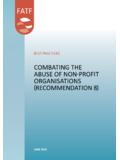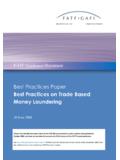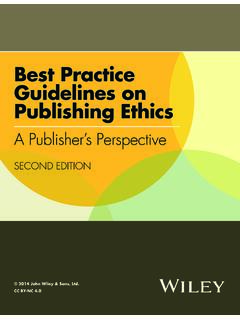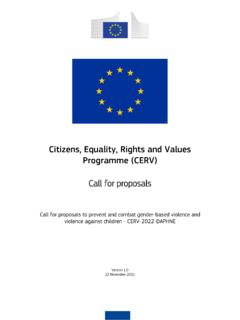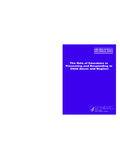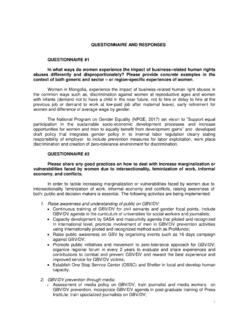Transcription of COMBATING THE ABUSE OF NON-PROFIT …
1 best PRACTICESCOMBATING THE ABUSE OF NON-PROFIT ORGANISATIONS (RECOMMENDATION 8)JUNE 2015 FINANCIAL ACTION TASK FORCE The Financial Action Task Force (FATF) is an independent inter-governmental body that develops and promotes policies to protect the global financial system against money laundering, terrorist financing and the financing of proliferation of weapons of mass destruction. The FATF Recommendations are recognised as the global anti-money laundering (AML) and counter-terrorist financing (CFT) standard. For more information about the FATF, please visit the website: 2015 FATF/OECD. All rights reserved. No reproduction or translation of this publication may be made without prior written permission. Applications for such permission, for all or part of this publication, should be made to the FATF Secretariat, 2 rue Andr Pascal 75775 Paris Cedex 16, France (fax: +33 1 44 30 61 37 or e-mail: Photocredits coverphoto: Thinkstock best practices PAPER ON COMBATING THE ABUSE OF NON-PROFIT ORGANISATIONS RECOMMENDATION 8 2015 1 TABLE OF ACRONYMS TABLE OF ACRONYMS.)
2 2 best practices PAPER ON COMBATING THE ABUSE OF NON-PROFIT ORGANISATIONS (RECOMMENDATION 8) .. 3 I. INTRODUCTION AND BACKGROUND .. 4 II. PURPOSE AND CONTEXT .. 6 III. GUIDANCE AND EXAMPLES OF GOOD PRACTICE FOR COUNTRIES .. 10 A. Understanding the risk .. 10 B. Mitigating the 14 IV. ACTIONS NPOS CAN TAKE TO PROTECT AGAINST TF ABUSE .. 22 A. Risk Analysis and Risk-Based Approach .. 22 B. Mitigating the Risk .. 22 C. Self-Regulation .. 23 V. ACCESS OF NPOS TO FINANCIAL SERVICES .. 28 ANNEX 1 EXAMPLES OF MEASURES THAT COUNTRIES HAVE IMPLEMENTED AND WHICH MAY, DEPENDING ON THE CIRCUMSTANCES, HELP TO MITIGATE RISK .. 32 OUTREACH TO THE SECTOR .. 33 SUPERVISION OR MONITORING .. 38 EFFECTIVE INVESTIGATION AND INFORMATION GATHERING .. 40 EFFECTIVE MECHANISMS FOR INTERNATIONAL COOPERATION .. 43 ANNEX 2 EXAMPLES OF MEASURES THAT NPOS HAVE IMPLEMENTED AND WHICH MAY, DEPENDING ON THE CIRCUMSTANCES, HELP TO MITIGATE RISK .. 44 ORGANISATIONAL INTEGRITY.
3 45 PARTNER RELATIONSHIPS .. 50 FINANCIAL ACCOUNTABILITY AND TRANSPARENCY .. 52 PROGRAMME PLANNING AND MONITORING .. 56 ANNEX 3 A LIST OF REPRESENTATIONAL AND SELF-REGULATORY ORGANISATIONS .. 59 REFERENCES AND BIBLIOGRAPHIE .. 68 best practices PAPER ON COMBATING THE ABUSE OF NON-PROFIT ORGANISATIONS RECOMMENDATION 8 2 2015 TABLE OF ACRONYMS AML Anti-money laundering CRA Canada Revenue Agency CFT Countering the financing of terrorism DNFBP Designated non-financial businesses and professions FIU Financial intelligence unit ML Money laundering NGO Non-government organisation NPO NON-PROFIT organisation RBA Risk-based approach TF Terrorist financing UNSCR United Nations Security Council Resolution best practices PAPER ON COMBATING THE ABUSE OF NON-PROFIT ORGANISATIONS RECOMMENDATION 8 2015 3 best practices PAPER ON COMBATING THE ABUSE OF NON-PROFIT ORGANISATIONS (RECOMMENDATION 8) This guidance paper should be read in conjunction with: the FATF Recommendations, especially Recommendation 8 and its Interpretive Note, and Recommendation 1 and its Interpretive Note, and the FATF typologies report on the Risk of Terrorist ABUSE in NON-PROFIT Organisations.
4 Other relevant FATF documents include: the guidance on National Money Laundering and Terrorist Financing Risk Assessment the typologies report on Terrorist Financing the Risk-Based Approach Guidance for the Banking Sector, and the Revised Guidance on AML/CFT and Financial Inclusion. best practices PAPER ON COMBATING THE ABUSE OF NON-PROFIT ORGANISATIONS RECOMMENDATION 8 4 2015 I. INTRODUCTION AND BACKGROUND 1. The Financial Action Task Force (FATF) best practices Paper on COMBATING the ABUSE of NON-PROFIT Organisations was first written in 2002 at a time when the FATF had just introduced standards to address specific terrorist financing (TF) vulnerabilities and threats in the wake of the 11 September 2001 terrorist attacks. Since then, the threat environment has evolved, government experience implementing Recommendation 8 has advanced, and the NON-PROFIT organisation (NPO) sector and self-regulatory mechanisms have also continued to evolve.
5 A limited update of the best practices paper was conducted in 2013 with specific input from the NPO sector to reflect the revised FATF Recommendations and the need to protect the legitimate activities of NPOs. The FATF published a typologies report on the Risk of Terrorist ABUSE in NON-PROFIT Organisations (the typologies report) in June 2014, and the best practices paper has now been further revised to reflect some of the findings of that report along with additional input and examples of good practice from governments and the private sector. 2. The FATF recognises the vital importance of the NPO community in providing charitable services around the world, as well as the difficulty of providing assistance to those in need, often in remote regions, and applauds the efforts of the NPO community to meet such needs. One of the main objectives of this best practices paper is to facilitate NPO efforts and protect the integrity of the NPO sector by providing examples of additional ways that governments and the NPO sector can work towards protecting the global NPO sector from terrorist ABUSE .
6 These good practices are not mandatory elements of the FATF Standards1, and are included as examples only. 3. The FATF is committed to maintaining a close and constructive dialogue with the private sector, including the NPO sector, as important partners in ensuring the integrity of the financial system. 4. The FATF recognises the intent and efforts to date of the NPO community to promote transparency within their operations and to prevent misuse of the sector by those wishing to support terrorist financing and terrorist organisations. The NPO sector in many countries has representational and self-regulatory organisations that have developed standards and initiatives to help individual organisations ensure accountability and transparency in their operations, including strengthened internal controls and risk mitigation measures. A sampling of representational and self-regulatory organisations can be found in Annex 3.
7 5. However, more than a decade after the ABUSE of NPOs by terrorists and terrorist organisations was formally recognised as a concern, some NPOs in the sector continue to be misused and exploited by terrorists through a variety of means. In fact, terrorist actors will often employ deception to mask their activities, particularly those in conflict regions. Well-planned deceptions by terrorists abusing the NPO sector are difficult to penetrate with the resources 1 The FATF Standards comprise the FATF Recommendations and their Interpretive Notes. best practices PAPER ON COMBATING THE ABUSE OF NON-PROFIT ORGANISATIONS RECOMMENDATION 8 2015 5 available to non-governmental actors, making state-based oversight and its capabilities a necessary element to detecting the most sophisticated terrorist threats to the NPO sector.
8 best practices PAPER ON COMBATING THE ABUSE OF NON-PROFIT ORGANISATIONS RECOMMENDATION 8 6 2015 II. PURPOSE AND CONTEXT 6. The purpose of this best practices paper is to set out specific examples of good practice which: a) Primarily assist countries2 in their implementation of Recommendation 8 on NON-PROFIT organisations, in line with Recommendation 1 and the risk-based approach, and consistent with countries obligations to respect freedom of association, assembly, expression, religion or belief, and international humanitarian law;3 b) May assist NPOs which fall within the scope of the FATF definition of a NON-PROFIT organisation to help meet the objectives of Recommendation 8 and mitigate TF threats they may face; and c) May assist financial institutions in the proper implementation of a risk-based approach when providing financial services to NPOs, and guide donors who are providing funding to NPOs.
9 7. The following context is particularly important to keep in mind when implementing the requirements of Recommendation 8 and its Interpretive Note, and when considering the examples of good practice set out in this paper: a) Recommendation 8 does not apply to the NPO sector as a whole. Countries should take a targeted approach to implementing the measures called for in Recommendation 8, including oversight and regulatory mechanisms, based on an understanding of the diversity of the NPO sector and the terrorism risks faced by the domestic NPO sector. Given the variety of legal forms that NPOs can have, depending on the country, the FATF has adopted a functional definition of NPO. This definition is based on those activities and characteristics of an organisation which put it at risk of terrorist ABUSE , rather than on the simple fact that it is operating on a NON-PROFIT basis.
10 Recommendation 8 only applies to those NPOs which fall within the FATF definition of a NON-PROFIT organisation . 2 All references to country or countries apply equally to territories or jurisdictions. 3 See also the United Nations Global Counter-Terrorism Strategy adopted in September 2006, which includes section IV. Measures to ensure respect for human rights for all and the rule of law as the fundamental basis of the fight against terrorism. The Preamble of the UN Security Council Resolution 2129(2013) states that the Council recognises the need for Member States to prevent the ABUSE of non-governmental, NON-PROFIT and charitable organisations by and for terrorists, and calling upon non-governmental, NON-PROFIT , and charitable organisations to prevent and oppose, as appropriate, attempts by terrorists to ABUSE their status, while recalling the importance of fully respecting the rights to freedom of expression and association of individuals in civil society and freedom of religion or belief, and noting the relevant recommendation and guidance documents of the Financial Action Task Force.











